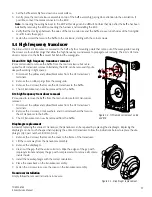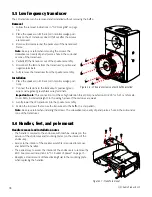
14
QSC Audio Products, LLC
when in OFF the front LED is always off. By setting this switch to LIMIT, the
LED is normally glows dimly but becomes bright when the DSP is limiting the
amplifiers, giving some feedback to the loudspeaker operation from the front
of the system.
On 2-way systems, HF and LF switches allow adjustment of the amplifier’s
response. The LF switch selects between EXT SUB with a 100Hz high-pass
filter, NORM that does not change the amplifier’s natural response, and DEEP
which provides boost at low frequencies which diminishes as volume increas-
es. Setting the HF switch to FLAT also has no response change while selecting
VOCAL BOOST increases the amplifier’s gain only in the mid frequencies to
help bring out the typical frequency range of the human voice. The subwoofer
BOP has a MODE switch instead of LF, with NORMAL and DEEP selections,
equivalent to FLAT and DEEP on 2-way systems. The HF switch is replaced by
a POLARITY switch in subwoofer versions, with the self-explanatory choices of
NORMAL and REVERSE.
The final connector on the faceplate of BOP is a versatile 3 pin ‘Euro’ header
called REMOTE GAIN. The +5V pin, naturally, su5V and is internally
protected and current limited by an op amp; the chassis ground pin is earth
ground. The middle pin, labeled with a triangle having the tall side by the +5V,
can be used to adjust the level of the BOP output. With nothing connected
to this pin, it is internally pulled up to +5V and the output is not attenuated.
When at ground, the DSP output, and thus the amplifier output, is muted.
Any voltage b5V and ground continuously adjusts the BOP output
level by varying the DSP output level. Connecting a potentiometer between
+5V and ground, with the wiper on the attenuation pin, allows full control of
volume. Because the attenuation pin is buffered, a single pot can control the
level of multiple BOPs. Voltage can also be injected into the connector, or a
contact can pull the attenuation pin to ground to affect a muting function.
Protection systems
As with all audio amplifiers, full rated power is only required for brief program peaks and typical use rarely exceeds 1/8
average power. High peak power must be able to flow for reasonable periods of time, while providing various protective sys-
tems that limit this power to reasonable long-term levels. The amplifier’s protection systems rely on the DSP to perform all
protection systems except amplifier OC, based on predetermined limits and operating conditions of the amplifier and trans-
ducers. A thermal sensor is placed near the amplifier FETs and is read by the DSP to perform thermal limiting and muting,
but also for fan speed control. Measurement of the amplifier output current is done by the gate driver which terminates a
PWM pulse if the current rises above a certain level. Muting of the amplifier, by the gate driver or DSP, occurs only if stresses
continue to build up.
As part of the current loop of the power supply, cycle-by-cycle current limiting will protect the power supply FETs from
damage. Another advantage of having the power supply current monitored is that the maximum AC mains current can be
limited in case the mains voltage drops below a level at which the amplifier should not be allowed to output full power.
Although the DSP signal level limiting and power supply current limiting will keep the mains current draw from blowing the
fuse in normal operation, a fuse is present and will open under catastrophic circumstances.
Summary of Contents for K8
Page 2: ...2 QSC Audio Products LLC...















































